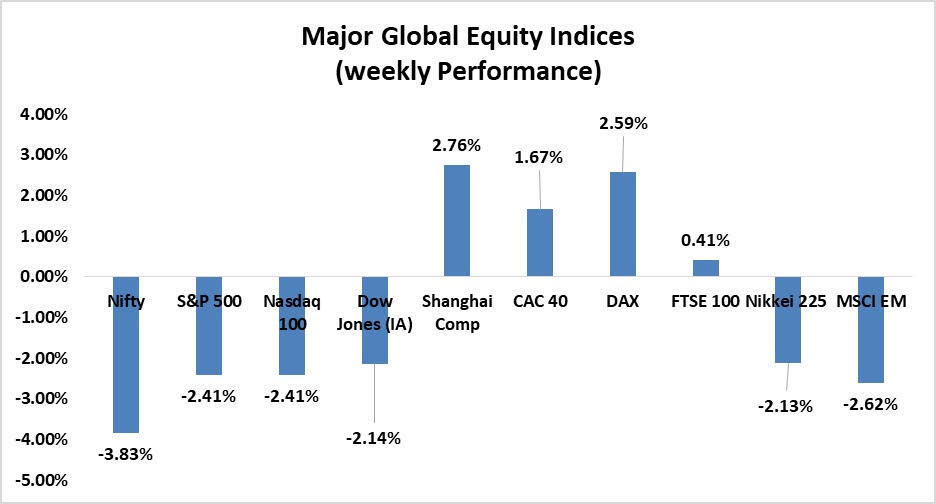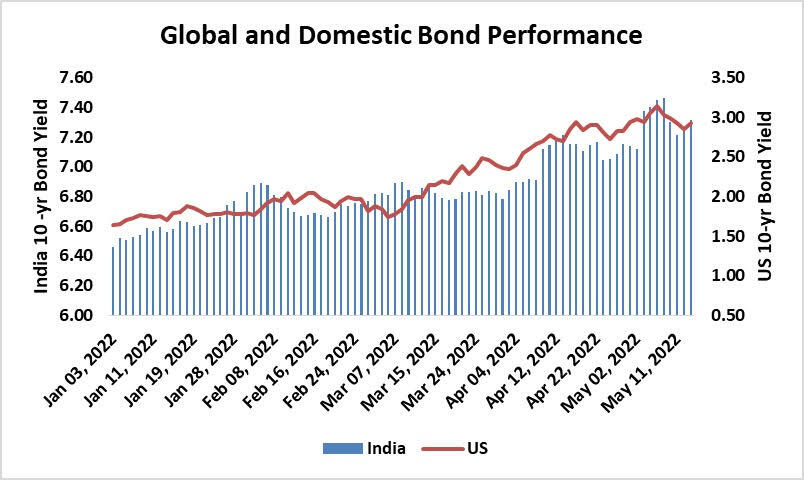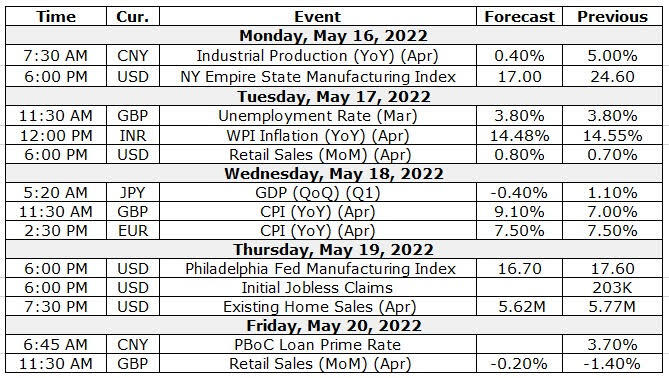Key highlights
- UK economy shrank 0.1% in March as inflation and the Ukraine war takes a toll.
- US Inflation barreled ahead at 8.3% in April from a year ago, remaining near 40-year highs.
- Morgan Stanley cuts India growth estimates and warns of 'worsening' macros.
- China's money supply expanded in April as the central bank unleashed more liquidity
- Bank of Japan chief rules out the near-term chance of tweaking dovish guidance
- India’s Forex reserves fall $1.774 billion to $595.954 billion
USD/INR weekly performance & outlook
The USD/INR pair made a gap up opening at 77.12 and remained volatile during the week. The pair closed the last day of the trading session at 77.44 levels. The USDINR ended higher tracking a weak domestic stock index and a strong dollar on fear of an aggressive rate hike by the Federal Reserve and global risk aversion. Market's fears were mainly propelled by the inflation woes that push global central bankers toward dialing back the easy money and challenging the already weary economic growth. The elevated crude prices also kept the Indian rupee under pressure. The Indian Rupee is expected to remain under pressure amid a strong dollar and elevating inflationary pressure in India. Persistent FII outflows are also expected to weigh on the domestic currency. The US dollar is expected to remain strong in the week ahead amid risk aversion in the global market. Additionally, the outlook for the global economy is looking gloomy amid supply chain disruption, lockdown in China, and Russia’s war against Ukraine which is expected to keep the safe-haven dollar in demand. Since the time Russia invaded Ukraine, the Rupee has depreciated about 3.8% while other EM currencies have depreciated 4-7%. The Rupee has therefore strengthened in relative terms which are reflected in the 36 country REER which is at 123. The CNHINR has dropped 6.5% from its peak of 12.20 in March to 11.39 currently. The reason why RBI would have let the Rupee appreciate against the Yuan could have been to keep imported inflation in check at a time when food and fuel inflation are already high.
EUR/USD
The EURUSD pair finally left its consolidating phase after falling to a multi-year low of 1.0350. It closed the week a handful of pips above 1.0400 figures. The collapse took place on Thursday, following the release of US inflation figures the day before. The news that Finland is likely to apply for NATO membership in a matter of days and Russia's statement that it would take retaliatory steps if Finland joined the NATO, severely impacted the euro. Also, Ukraine's halting of Russia's gas flows also brought in the fear of higher inflation in the Eurozone. The outlook still remains tilted towards the bearish, in response to dollar dynamics, geopolitical concerns, and the Fed-ECB divergence. Multiple ECB officials stated that they would be comfortable hiking rates right after finishing the massive bond-buying program known as APP in July. The focus would be on the GDP, ECB President Lagarde's speech, and CPI data expected to be released later in the week.
Bank of England interest rate could hit 4% or more, ex-policymakers warn
GBP/USD
The Bank of England’s policy announcements-led sell-off extended into a second week, with cable making fresh multi-month lows almost each new trading day. The UK economy contracted 0.1% MoM in March while recording a meager 0.8% expansion in Q1 2022, exacerbating the pain in the pound. The GBPUSD pair sold off aggressively, as the macroeconomic, as well as, monetary policy divergence between the UK and US returned to the fore. Further, markets witnessed a classic risk-off profile that favored the ultimate safe-haven, the dollar, in times of mounting growth worries. A relief rally seeped into the final trading day of the week, offering a temporary reprieve to GBP bulls, as the dollar corrected amid an improving mood. Heading into a new week, the cable is looking to find a bottom, with all eyes on the US Retail Sales and UK inflation data. The pessimism surrounding Brexit and the UK's economic fears are negatives that are expected to keep the cable under pressure in the week ahead.
Global markets in recovery mode, the dollar index continues to climb
Dollar Index
The dollar shed some ground after hitting fresh peaks of 105 on Friday. The recent sharp move higher was exclusively in response to the abrupt re-emergence of the risk aversion. The index came under some selling pressure in the last trading session against the backdrop of a mild improvement in the risk-associated universe. Supporting the dollar appeared investors’ expectations of a tighter rate path by the Federal Reserve and its correlation to yields, the current elevated inflation narrative, and the solid health of the labour market. On the negative for the dollar turn up the incipient speculation of a “hard landing” of the US economy as a result of the Fed’s more aggressive normalization. The dollar index is expected to trade with a neutral to bullish bias on the back of a stronger dollar.
Domestic and global equities
Domestic equities
The India Nifty 50 traded in the range of 15,738- 16,404 over the week and closed with a downside. Auto, pharma, and FMCG were the only ones who remained on the positive side over the week rest sectors remained under pressure. Indian markets have corrected in the last few weeks due to rising global yields to counter inflation. A surprise hike by the RBI also contributed to this recent correction. Some small corrections further can’t be ruled out and volatility may remain at elevated levels due to tightening liquidity and earning season.
Global equities
US Stocks recorded another week of losses, as investors appeared to grow increasingly skeptical that the Federal Reserve will be able to achieve a “soft landing” for the economy by raising rates enough to tame inflation without causing a recession. Shares in Europe rebounded from earlier weakness to finish higher, despite ongoing concerns about inflation, tightening monetary policy, and the economic outlook. Japan’s stock markets fell over the week, as expectations that the U.S. Federal Reserve would aggressively tighten monetary policy, concerns about slowing global growth, and the economic implications of the war between Russia and Ukraine continued to weigh on risk appetite.
Domestic and global bonds
Domestic bonds
The yield on the domestic 10-year benchmark bond yield declined initially during the week, amid speculation that the Reserve Bank of India may soon buy debt to cap surging yields. However, later in the week, the bonds gave up the initial gains as the yields continued to move north. The 10-year government bond yield rose after India's consumer price inflation hit a nearly eight-year high, suggesting faster tightening by the Reserve Bank of India. Higher crude oil prices and US treasury yields also weighed on domestic bonds. The India 10-year benchmark closed the last trading session at 7.318 levels. the bond market is expected to remain under pressure on the back of high crude prices, elevated domestic inflation, and FII outflows.
Global bonds
The 10-year U.S. Treasury yield slipped below 3% after a release of key inflation data showed a faster-than-expected rise in prices. Initially, during the week, investors appeared to have rotated out of stocks and into Treasury in search of a safe haven, as persistently high inflation data has fueled recession fears. However, later in the week, the U.S. Treasury yields jumped, as investors sold out of government bonds and looked to move back into stock markets. The yield on the benchmark 10-year Treasury note surged to close the week at 2.93%.
Monthly FPI net investments
Over the past eight months, foreign institutional investors have embarked on their largest selling spree in Indian equities since the global financial crisis of 2008-09. The outflow is expected to continue in the week ahead due to the strengthening of dollars, aggressive rate hike expectation by the Federal Reserve, elevated global inflation, and other global cues which is making the emerging market less attractive compared to the US. Foreign Institutional Investors have net sold Indian equities every single month since October 2022. It is no secret that global factors are not exactly conducive for bulls to dominate stock markets at the current juncture. A host of central banks, including that of the world’s largest economy, have embarked on an aggressive monetary tightening cycle, implying tighter financial conditions the world over. The net outflow to date in the May month from equity and debt combined stood at INR -21390 crores.
Macro-economic calendar
This report has been prepared by IFA Global. IFA Global shall not be in any way responsible for any loss or damage that may arise to any person from any inadvertent error in the information contained in this report. IFA Global nor any of directors, employees, agents or representatives shall be held liable for any damages whether direct, indirect, special or consequential including lost revenue or lost profits that may arise from or in connection with the use of the information. No liability whatsoever is accepted for any loss arising (whether direct or consequential) from any use of the information contained in this report. This statement, prepared specifically at the addressee(s) request is for information contained in this statement. All market prices, service taxes and other levies are subject to change without notice. Also the value, income, appreciation, returns, yield of any of the securities or any other financial instruments mentioned in this statement are based on current market conditions and as per the last details available with us and subject to change. The levels and bases of, and reliefs from, taxation can change. The securities / units / other instruments mentioned in this report may or may not be live at the time of statement generation. Please note, however, that some data has been derived from sources that we believe to be reliable but is not guaranteed. Please review this information for accuracy as IFA Global cannot be responsible for omitted or misstated data. IFA Global is not liable for any delay in the receipt of this statement. This information is strictly confidential and is being furnished to you solely for your information. This information should not be reproduced or redistributed or passed on directly or indirectly in any form to any other person or published, copied, in whole or in part, for any purpose. This report is not directed or intended for distribution to, or use by, any person or entity who is a citizen or resident of or located in any locality, state, country or other jurisdiction, where such distribution, publication, availability or use would be contrary to law, regulation or which would subject IFA Global to any registration or licensing requirements within such jurisdiction. The information given in this report is as of the date of this report and there can be no assurance that future results or events will be consistent with this information. IFA Global reserves the right to make modifications and alterations to this statement as may be required from time to time. However, IFA Global is under no obligation to update or keep the information current. Nevertheless, IFA Global is committed to providing independent and transparent information to its client and would be happy to provide any information in response to specific client queries. Neither IFA Global nor any of its directors, employees, agents or representatives shall be liable for any damages whether direct, indirect, special or consequential including lost revenue or lost profits that may arise from or in connection with the use of the information. The information provided in these report remains, unless otherwise stated, the copyright of IFA Global. All layout, design, original artwork, concepts and other Intellectual Properties, remains the property and copyright IFA Global and may not be used in any form or for any purpose whatsoever by any party without the express written permission of the copyright holders.
Recommended Content
Editors’ Picks
EUR/USD edges lower toward 1.0700 post-US PCE

EUR/USD stays under modest bearish pressure but manages to hold above 1.0700 in the American session on Friday. The US Dollar (USD) gathers strength against its rivals after the stronger-than-forecast PCE inflation data, not allowing the pair to gain traction.
GBP/USD retreats to 1.2500 on renewed USD strength

GBP/USD lost its traction and turned negative on the day near 1.2500. Following the stronger-than-expected PCE inflation readings from the US, the USD stays resilient and makes it difficult for the pair to gather recovery momentum.
Gold struggles to hold above $2,350 following US inflation

Gold turned south and declined toward $2,340, erasing a large portion of its daily gains, as the USD benefited from PCE inflation data. The benchmark 10-year US yield, however, stays in negative territory and helps XAU/USD limit its losses.
Bitcoin Weekly Forecast: BTC’s next breakout could propel it to $80,000 Premium

Bitcoin’s recent price consolidation could be nearing its end as technical indicators and on-chain metrics suggest a potential upward breakout. However, this move would not be straightforward and could punish impatient investors.
Week ahead – Hawkish risk as Fed and NFP on tap, Eurozone data eyed too

Fed meets on Wednesday as US inflation stays elevated. Will Friday’s jobs report bring relief or more angst for the markets? Eurozone flash GDP and CPI numbers in focus for the Euro.





